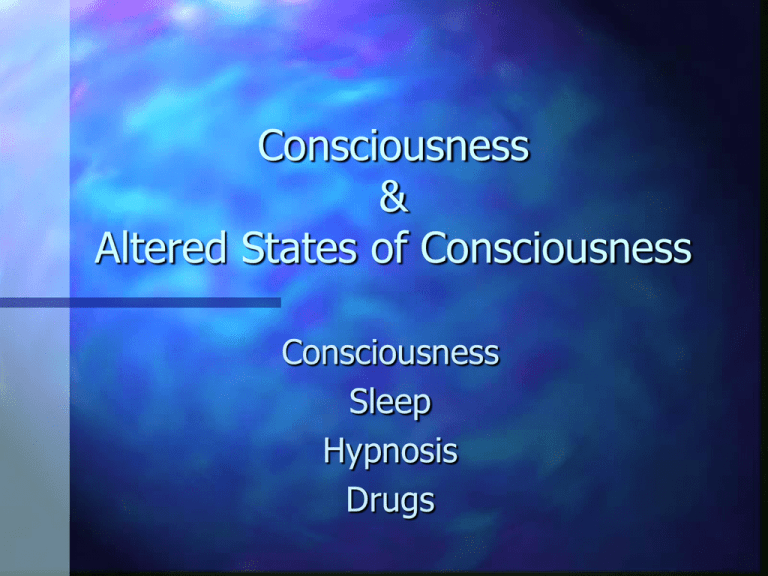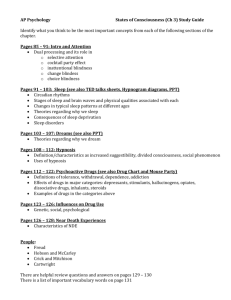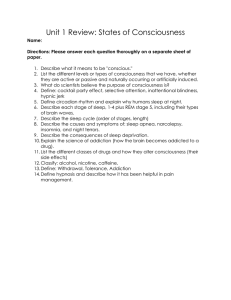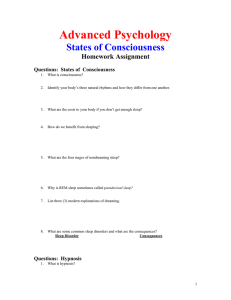Consciousness
advertisement

Consciousness & Altered States of Consciousness Consciousness Sleep Hypnosis Drugs Definitions of Consciousness Allow Its Empirical Study Subjectivity and “qualia” – How do we know that your idea of red and my idea of red are the same idea? Access to Information – We have access to some information in our minds (i.e., our consciousness), but we don’t have access to other information in our minds (i.e., our unconscious) Unitary Experience – The outputs of our sensory systems are unified into a phenomenal experience that is continuous over time Manipulating objects with the mind Implant small electrodes in the frontal and parietal lobe of a monkey Record electrical activity in those areas while the monkey is using a joystick to manipulate a robotic arm Create an “index” for the robotic arm, such that certain patterns of brain activity indicate certain movements Unplug the joystick and make movement of the robotic arm completely dependent on brain activity Within days, the monkey was able to control the robotic arm with only it’s thoughts Variations in conscious experience Automatic vs. controlled processing – Typically, automatic processing is fast and is done without much conscious effort (e.g., driving on a dry highway without much traffic) – Typically, controlled processing is slower and is done with conscious effort (e.g., driving on a wet highway with a lot of traffic) Comas: vegetative to minimally conscious – Brain imaging can help determine the nature of the coma Thalamic stimulation The Corpus Callosum Millions of myelinated axons connecting the brain’s hemispheres Provides a pathway for communication between the hemispheres If surgically severed for treatment of epilepsy, hemispheres cannot communicate directly Visual Processing Both eyes send information to both hemispheres Right half of the visual field goes to the left hemisphere Left half of the visual field goes to the right hemisphere Sperry’s Split-Brain Experiment Split-brain subjects could not name objects shown only to the right hemisphere If asked to select these objects with their left hand, they succeeded but they could not say why The right side of the brain doesn’t control speech The interpreter The left hemisphere likes to construct a world that makes sense. – It may even seek patterns that might not exist. Unconscious Processing Influences Awareness The case for unconscious influence: – Subliminal perception (see next slide) – Freudian slips – Priming The smart unconscious – Incubation effects – Verbal overshadowing Blindsight Global workspace model of consciousness Subliminal Perception Priming is quicker retrieval of words related to previous stimuli Priming works even if previous words are presented subliminally – That is, the words are presented in such a way that the subject claims not to have perceived them. This is more evidence for the influence unconscious processing on awareness. Sleep and Dreams Measuring Sleep Stages of Sleep Why Do We Sleep? Dreams Sleep Disturbances Measuring Sleep Electrodes measure – eye movements – EMG Electromyogram – EEG Electroencephalogram A camera may also record body movements Stages of Sleep A Typical Night’s Sleep Typically 4-5 episodes of REM sleep per night – Later episodes are longer and farther apart Most “deep sleep” (stages 3 & 4) occurs early Sleep disorders Insomnia – Pseudoinsomnia – Worrying Cognitive-behavioral therapy can help Sleep apnea Narcolepsy Sleepwalking (somnambulism) Why do we sleep: Restoration – Sleep allows the body to repair itself. – Sleep deprivation Microsleeps Can cause problems with mood and cognitive performance Circadian Rhythms – Keep animals quiet and inactive during the most dangerous part of the day (night for humans) Consolidation – Neuronal connections that serve as the basis for new learning is strengthened during sleep. Who Sleeps How Much? Dreams Recalling dreams is rare, but dreaming isn’t – A normal person may dream 150,000 times in their lifetime People report dreams 80% of the time during REM sleep, but less than 50% of the time during other stages – REM dreams are more bizarre; non-REM dreams are often boring People have less REM sleep with age – In newborns, 50% of sleep is REM – In the elderly, about 20% of sleep is REM What Do We Dream About? 64% of dreams associated with sadness, fear, or anger – Aggressive acts outnumbered friendly acts by 2:1 18% of dreams were happy or exciting 29% of dreams were in color Dream Theories Sigmund Freud believed that dreams expressed wishes, often disguised – Manifest Content Conscious dream content that is remembered after awakening – Latent Content The unconscious, uncensored meaning of a dream Alan Hobson activation-synthesis theory – Random activation from the pons and the amygdala activate visual systems and memory systems and the mind attempts to interpret these random patterns Sleep Disturbances Insomnia – Inability to fall asleep, stay asleep, or get enough sleep to function during the day Hypersomnia (Narcolepsy) – A type of; irresistible, sudden attacks of drowsiness during the day Parasomnia (Sleep disturbance) – Apnea: Repeated cessation of breathing during sleep Hypnosis Hypnosis Hypnotic induction – Attention-focusing procedures in which changes in a person’s behavior or mental state are suggested Hypnotic Susceptibility – The extent to which an individual is characteristically responsive to hypnosis Posthypnotic suggestion – A suggestion made to a subject in hypnosis to be carried out after the induction session is over Can Hypnosis Enhance Eyewitness Testimony? Participants saw videotape of a staged bank robbery Half were then hypnotized Re-intervivew mentioned robber wore a mask – There was no mask In highly hypnotizable subjects, 63% had false memories The Hidden Observer Subjects held a hand in ice water and reported pain Hypnotized subjects reported lower pain Hypnotized subjects reported a “hidden observer” that was aware of the pain How Do Drugs Affect Consciousness? People Use—and Abuse—Many Psychoactive Drugs Alcohol Is the Most Widely Abused Drug Addiction Has Psychological and Physical Aspects People Use—and Abuse— Many Psychoactive Drugs Marijuana – most widely used illegal drug Stimulants – Cocaine and amphetamines (speed, meth, etc.) improve mood cause restlessness and disrupt sleep MDMA (“ecstasy”) – similar effects as stimulants, with slight hallucinations Opiates – Heroin, morphine, codeine – Highly addictive due to dual activation of dopamine and opiate receptors Alcohol Is the Most Widely Abused Drug Alcoholism is the third largest health problem, following heart disease and cancer – Currently 5% of all Americans are active alcoholics Another 3% are addicted to other drugs – Lifetime prevalence is 10-20% Americans have a love/hate relationship with alcohol – On the one hand, moderate drinking is an accepted aspect of normal social interaction and may even be good for health. – On the other hand, alcohol is a major contributor to many of our societal problems, such as spousal abuse and other forms of violence. Alcohol Is the Most Widely Abused Drug Expectations – alcohol reduces anxiety – alcohol increases social skills, sexual pleasure, confidence, and power Reality – large doses of alcohol result in negative moods and focus on problems and anxieties – Alcohol impairs motor processes, information processing, mood, sexual performance – Learned beliefs about intoxication influence behavior Addiction Has Psychological and Physical Aspects Addiction – a physiological state in which failing to ingest a substance leads to symptoms of withdrawal, a state characterized by anxiety, tension, and craving Physical dependence – associated with tolerance, so that a person needs to consume more of the substance to achieve the same subjective effect Psychological dependence – – – habitual and compulsive engagement despite the consequences people can be psychologically dependent without showing tolerance or withdrawal individuals can be psychologically dependent on behaviors like gambling, shopping, exercising, or internet use



